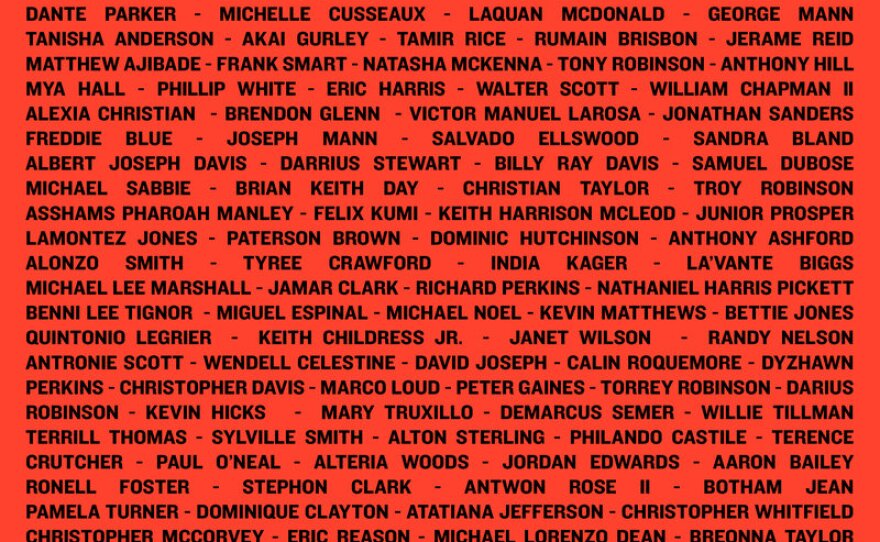The last few weeks have been filled with devastating news — stories about the police killing black people. At this point, these calamities feel familiar — so familiar, in fact, that their details have begun to echo each other.
In July 2014, a cellphone video captured some of Eric Garner's final words as New York City police officers sat on his head and pinned him to the ground on a sidewalk: "I can't breathe." On May 25 of this year, the same words were spoken by George Floyd, who pleaded for release as an officer knelt on his neck and pinned him to the ground on a Minneapolis street.
We're at the point where the very words people use to plead for their lives can be repurposed as shorthand for completely separate tragedies.
Part of our job here at Code Switch is to contextualize and make sense of news like this. But it's hard to come up with something new to say. We covered the events in Ferguson, Mo., in August 2014 after Michael Brown was killed by the police, and we were in Baltimore after Freddie Gray's death in 2015. We covered the deaths of Eric Garner, Philando Castile, Alton Sterling, Delrawn Small.
We've talked about what happens when camera crews leave cities still reeling from police violence. We've reflected on how traumatizing it can be for black folks to consume news cycles about black death, the semantics of "uprisings" versus "riots" and how #HousingSegregationInEverything shapes police violence. All of these conversations are playing out again.
Since it's hard to come up with fresh insights about this phenomenon over and over and over, we thought we'd look back to another time, back in 2015, when the nation turned its collective attention to this perpetual problem. We invited Jamil Smith, a senior writer at Rolling Stone, to read from an essay that he wrote at The New Republic more than five years ago titled "What Does Seeing Black Men Die Do for You?"
In it, he writes:
"It seems sickly fitting that those killed by police today are no longer transformed into the anointed or the condemned, but, thanks to more advanced and available technology, they become hashtags. With a flood of more videotaped killings, a hashtag seems a brutally meager epitaph, a mere declaration that a victim of police violence was once alive, human, and didn't merit having her or his life stolen.
Unfortunately, the increased visibility of trauma and death at the hands of cops isn't doing as much as it should be. The legacy of our increased exposure to black death has merely been the deadening of our collective senses."
We also spent time creating a (very non-comprehensive) list of names of black folks killed by the police since Eric Garner's death in 2014. Using resources including Mapping Police Violence and The Guardian's "The Counted" series, we read the names of people from across the country, of all ages. Some, like Tamir Rice and Sandra Bland, were familiar to us. But others were new — a reminder that many black deaths at the hands of police don't make it to national news.
We wanted to learn more about each person's final moments before the police ended their lives. Here's some of what we learned:
Eric Garner had just broken up a fight, according to witness testimony.
Ezell Ford was walking in his neighborhood.
Michelle Cusseaux was changing the lock on her home's door when police arrived to take her to a mental health facility.
Tanisha Anderson was having a bad mental health episode, and her brother called 911.
Tamir Rice was playing in a park.
Natasha McKenna was having a schizophrenic episode when she was tazed in Fairfax, Va.
Walter Scott was going to an auto-parts store.
Bettie Jones answered the door to let Chicago police officers in to help her upstairs neighbor, who had called 911 to resolve a domestic dispute.
Philando Castile was driving home from dinner with his girlfriend.
Botham Jean was eating ice cream in his living room in Dallas.
Atatiana Jefferson was babysitting her nephew at home in Fort Worth, Texas.
Eric Reason was pulling into a parking spot at a local chicken and fish shop.
Dominique Clayton was sleeping in her bed.
Breonna Taylor was also asleep in her bed.
And George Floyd was at the grocery store.





